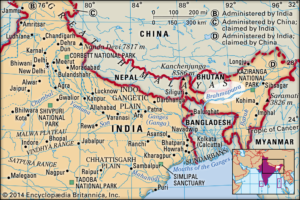In news: Recently, China has given green signal for first downstream dams on Brahmaputra
Key updates
- A draft of China’s new Five-Year Plan (2021-2025), which is set to be formally approved on March 11, has given the green light for the first dams to be built on the lower reaches of Yarlung Zangbo river, as the Brahmaputra is known in Tibet, before it flows into India.
- The long term object of the plan is the building of hydropower bases on the lower reaches(sections of the river in Tibet) of the river as among the priority energy projects to be undertaken in the next five years.
- As per the Chinese media reports, State-owned hydropower company POWERCHINA had signed “a strategic cooperation agreement” with the Tibet Autonomous Region (TAR) government to “implement hydropower exploitation in the downstream of the Yarlung Zangbo River
- The plan also proposes to have “clean energy bases” in the upper and lower reaches of Jinsha river (the upper course of Yangtze river in western China).
- Other major projects include the construction of coastal nuclear power plants and power transmission channels.
- Infrastructure strategy: The proposed plan mentions significant planned investments in infrastructure that serve major national strategies.
- The project is also listed along with the Sichuan-Tibet railway and the national water network.
Other projects of China on Brahmaputra river
In 2015 China operationalised its first hydropower project at Zangmu in Tibet, while three other dams at Dagu, Jiexu and Jiacha are being developed, all on the upper and middle reaches of the river.
What is the concern?
Dams on the lower reaches and at the Great Bend would, however, raise fresh concerns because of the location across the border from Arunachal Pradesh and the potential impact downstream.
The Brahmaputra river
- The Brahmaputra, called Yarlung Tsangpo in Tibet, Jamuna in Bengali, Siang/Dihang River in Arunachal Pradesh and Luit, Dilao in Assam, is a trans-boundary river which flows through Tibet, India and Bangladesh
- The river originates from the Kailash ranges of Himalayas at an elevation of 5300 M
- The catchments area of Brahmaputra in Tibet is 2, 93,000 Sq. Km; in India and Bhutan is 2,40,000 Sq. Km and in Bangladesh is 47,000 Sq. Km. The Brahmaputra basin extends over an area of 5,80,000 Sq. Km up to its confluence within Bangladesh.

Tributaries of Brahmaputra
The tributaries namely Subansiri, Ronganadi, Dikrong, Buroi, Borgong, Jiabharali, Dhansiri (North) Puthimari, Manas, Beki, Aie, Sonkosh are the main tributaries on the North while the Noadehing, Buridehing, Desang, Dikhow, Bhogdoi, Dhansiri (South), Kopilli, Kulsi, Krishnai, Dhdhnoi, Jinjiran are the main tributaries on the south bank of the river Brahmaputra
















